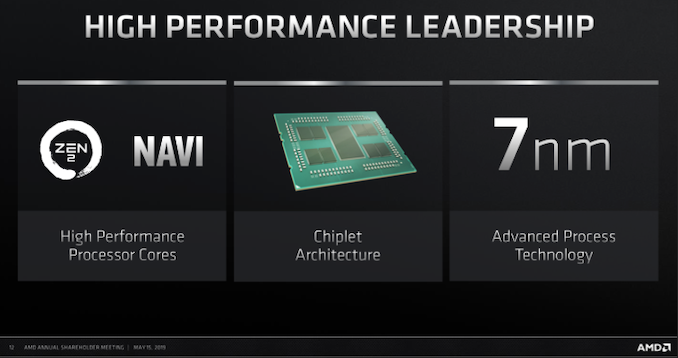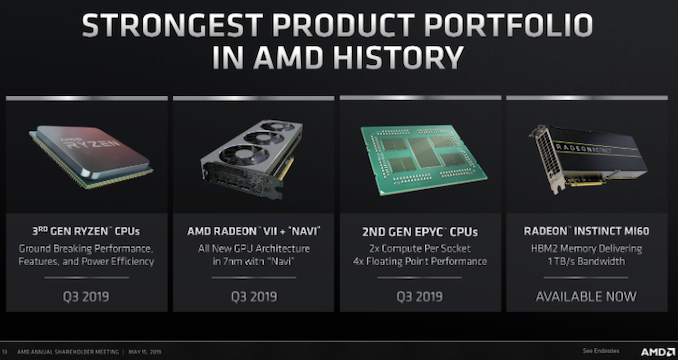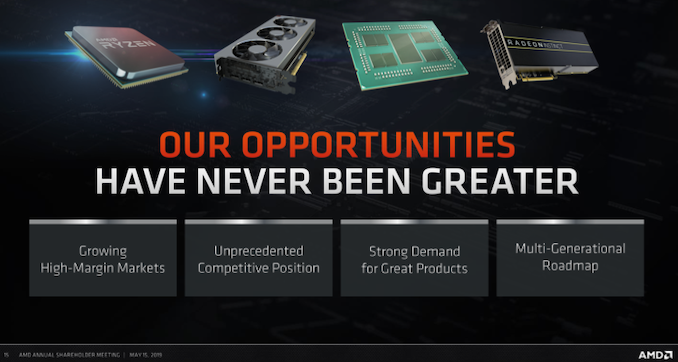AMD Reiterates 7nm Roadmap: Navi, Matisse, & Rome to Launch in Q3
by Anton Shilov on May 17, 2019 8:00 AM EST
AMD this week held its Annual Shareholder Meeting where it reiterated its current technology roadmap and once again confirmed that that its major products set to be released this year based on 7nm will be formally introduced in Q3. Previously the company implied on launch timeframes of its Navi GPU (at least one of them), Matisse CPUs, and Rome server CPUs, but never made a firm promise about the third quarter - this announcement is a commitment to delivering these products in Q3.
The High Level
On a high level, AMD believes that there are four technology pillars that will define its product roadmap in 2019 and forward. These pillars are: the Zen 2 CPU microarchitecture, its Navi GPU architecture, chiplet-based design architecture that enables it to mix and match features and technologies to build a right processor for a given platform, and IP for TSMC’s 7 nm manufacturing technology.
Since R&D processes take years, it was crucial for AMD to make the correct bets when its comes to microarchitecture and fabrication process. That said, this year’s product launches represent a culmination of multi-year efforts by the whole company, but considering that numerous architectural things may be re-used for years, it is important that they have been developed and implemented.
The Products
AMD’s 3rd Generation Ryzen processor, known as Matisse, promises a significant performance increase in general-purpose tasks from where AMD is today. It also adds several new features, such as PCIe 4.0 interface support. Launching this product “shortly in Q3” means that the company wants to make it available already during the important back-to-school season and well ahead of critically important holiday sales season.
Another vital product series for AMD is its next-gen lineup of GPUs based on its Navi architecture. At least one of these graphics processors will be launched in the third quarter. What is noteworthy is that Navi GPUs will coexist with AMD’s Radeon VII graphics cards, which indicates that the latter will continue to serve the enthusiast segment of the market. Furthermore, AMD’s 7nm Vega GPU in the form of the Radeon Instinct MI60 will continue to be offered for high-performance computing workloads.
Also due in Q3 are AMD’s 2nd Gen EPYC processors, known as Rome. These server CPUs are set to feature up to 64 cores powered by the company’s Zen 2 microarchitecture. It is worth keeping in mind that it takes server users some time to adopt new CPUs, and the launch of AMD’s 2nd Gen EPYC in Q3 does not necessarily mean that these processors will be used by a massive amount of designs straight away. Nonetheless, it is still important to release them rather sooner than later in a bid to ramp them up as soon as possible.
One product family worth mentioning is Threadripper. AMD's high-end desktop platform, currently available at 8-32 cores, is expected to be encroached on by the Ryzen 3000 series. AMD briefly held in its roadmaps that Threadripper based on Rome would be coming in 2019, however in its most recent disclosures, that commitment has no longer appeared and AMD has not commented on the matter. It could be that someone made a mistake putting it on the singular slide deck in which it appeared, or there's a level of inconsistency between AMD's presentation teams based on what they are presenting to whom. Hopefully AMD will clarify the matter in due course, and with Computex coming in two weeks, it would be a perfect time to do so.
Related Reading:
- AMD To Host “Next Horizon Gaming” Event & Product Unveil at E3 2019: June 10th, 3pm PT
- AMD: 7nm ‘Navi’ GPU & 'Rome' CPU to Launch in Q3
- AMD's 7nm CPUs & GPUs To Be Fabbed by TSMC, on Track for 2018 - 2019
- AMD Tech Day at CES: 2018 Roadmap Revealed, with Ryzen APUs, Zen+ on 12nm, Vega on 7nm
- AMD Unveils GPU Architecture Roadmap: After Polaris Comes Vega
Source: AMD













55 Comments
View All Comments
Maxiking - Sunday, May 19, 2019 - link
Are you mocking up the fact that AMD couldn't significantly outperform 14nm++ i9 9900k in thier public demo whilst demonstrating the new uber 7nm products and that close tie in the amd favoured benchmark was the best fakeout they could set up to hype the masses? If this is the best they could show imagine how slow it will be in the real life usage. But I am sure their cpus will be sold out thanks to the people visiting Fridays for future kekekekekKorguz - Sunday, May 19, 2019 - link
Maxiking he is probable mocking intel and their delays with 10nm, after all they have been promising 10nm for what.. 3 or 4 years now...they could be comparing engineering samples vs retail release samples...so performance could change
sounds like you are just hurt because intel isnt the tech leader it once was...
Smell This - Sunday, May 19, 2019 - link
Is there really such a thing as an *AMD-flavored benchmark*? I'm thinkin' poor ol' AMD has spent less on R&D over the years than the tens of billions of dollars Intel *subsidized* in marketing the Bay Trail Fails.Maybe Jimbo Keller can provide Chipzilly a *Thermal Velocity Boost* in the pants. Huh?
Rοb - Sunday, May 19, 2019 - link
Huh?! - "It is worth keeping in mind that it takes server users some time to adopt new CPUs, and the launch of AMD’s 2nd Gen EPYC in Q3 does not necessarily mean that these processors will be used by a massive amount of designs straight away. Nonetheless, it is still important to release them rather sooner than later in a bid to ramp them up as soon as possible.".-- Hawk: https://www.hlrs.de/en/whats-new/news/detail-view/... will have 640K cores and installation starts end of May: https://kb.hlrs.de/platforms/index.php/Hawk_instal... and the BullSequana XH2000 Supercomputer: https://atos.net/en/products/high-performance-comp... needs 200K cores --- 1M/64=15,625 CPUs.
-- TSMC 6nm is a 'die shrink': https://www.tsmc.com/tsmcdotcom/PRListingNewsActio... offering 18% greater density, so they could easily upgrade the 64 core CPUs to 72 cores.
The 7nm ones appear to be partially sold out (thus, no Threadripper), we hate waiting any longer but at the same time it makes sense for the 'general release' to have more cores using less power; and more PCIe 4 lanes wouldn't hurt, since 5*32=160.
tellthebell123 - Wednesday, August 14, 2019 - link
good blog!tellthebelll